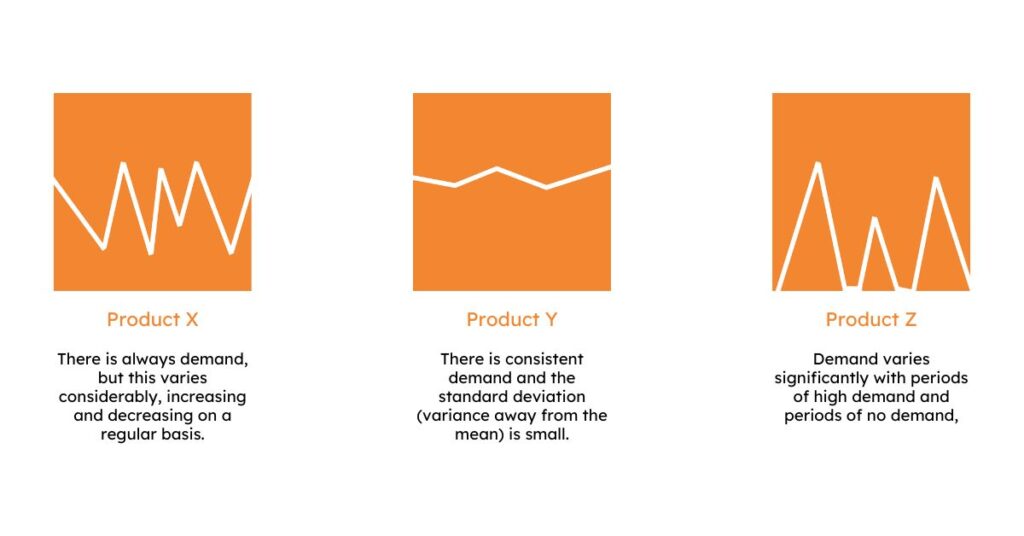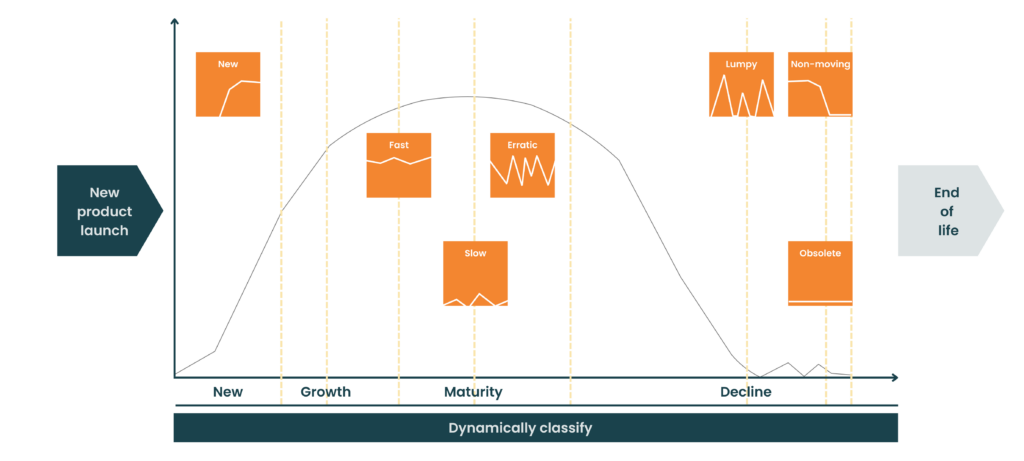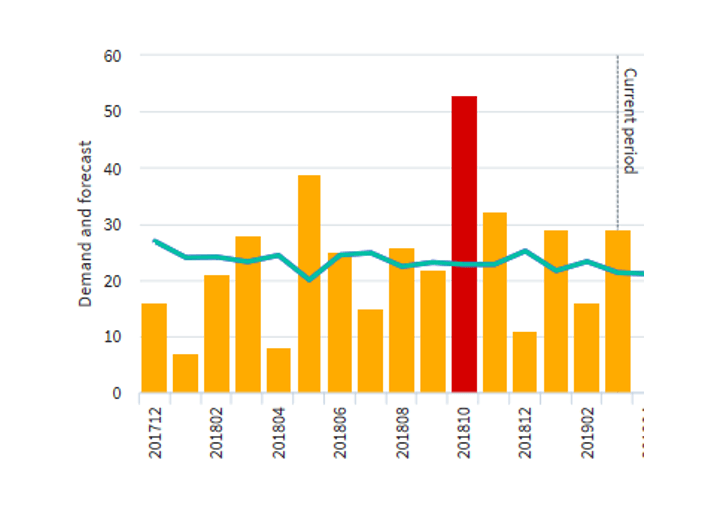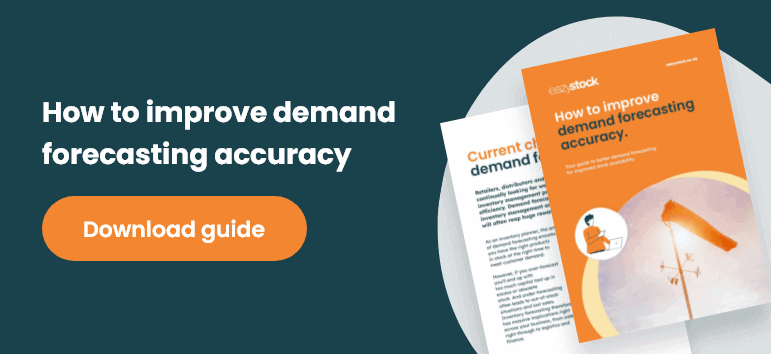8 best inventory demand forecasting techniques
Demand forecasting techniques
Demand forecasting techniques play a critical role in inventory management. If you can accurately forecast market demand, you can take action to ensure you hold the correct stock to maximize sales and profit. However, producing an accurate inventory demand forecast is no mean feat. In this post we uncover eight top demand forecasting techniques and best practice tips that you can’t be without.
But first – let’s get a definition:
What is inventory demand forecasting?
Inventory demand forecasting is the process of predicting customer demand for an inventory item over a defined period of time. Accurate inventory demand forecasting enables a company to hold the right amount of stock, without over or under-stocking, for optimum inventory control. Historical data trends and market knowledge of how demand can fluctuate are often used to forecast inventory demand.
The importance of accurate inventory forecasting
Forecasting inventory can be as basic or as complex as you make it. As a simple rule, the more sophisticated your inventory forecasting techniques, the more accurate your predictions will be. Accurate demand forecasts allow you to efficiently serve customers’ needs without investing capital in large amounts in stock, effectively helping you lower your overall operational costs. However, inventory forecasting can be challenging to undertake without the right guidance, so starting with basic forecasting techniques is advisable.
8 of the best demand forecasting techniques
There are many demand forecasting techniques a business can implement which can use both quantitative forecasting and (using historical demand data) and qualitative forecasting (based on more subjective opinions and insights) methods.
Here are our eight top demand forecasting techniques:
- Use demand types
- Identify trends
- Adjust forecasts for seasonality
- Include qualitative inputs
- Remove ‘real’ demand outliers
- Account for forecasting accuracy
- Understand your demand forecasting periods
- Consider demand forecasting software
Let’s take a closer look at each in more detail:
1. Inventory forecasting: demand types
If you analyzed the historical sales data of every product in your warehouse, you’d find that the demand for different items varies considerably. Some will have consistently high demand over time, for others there could be sporadic or low demand.
For example:

In addition, as products move through their product lifecycle from market entry to maturity and decline, their demand types will keep changing:

An item’s demand type is important, as it should be used to determine the type of calculation (or algorithm) you use for forecasting. It makes statistical sense to use a different equation to calculate the demand of a product with an erratic demand type, to one with slow demand.
Calculating your base demand is just the start of producing accurate demand forecasts. Below is an example of the different demand factors that can impact or inflate your normal base demand.
2. Inventory demand trends
The demand for your inventory items will ebb and flow as fashions change, new technologies replace old and social, economic and legal factors influence demand.
Items will also follow demand trends as they move through the product cycle. For example, in the growth phase, the trend in demand will be upwards, while in the decline phase, the trend will reverse.
Make sure you look out for trends in your historical demand data and adjust your inventory forecasts accordingly. There’s no point creating a forecast based solely on your base demand if items are following a specific trend.
3. Forecasting demand for seasonal items
Almost every manufacturer, distributor or retailer can expect to see seasonal demand fluctuations for some of their product lines. Seasonal weather patterns, school holidays and annual traditions all have a seasonal influence on demand.
Understanding how these seasonal factors affect your customers’ purchasing habits will help you take advantage of peaks in demand and plan for the troughs.
Best practice is to keep seasonal demand factors separate from your base demand calculations. This keeps the data clean and easier to use for forecasting going forward.
4. Qualitative inputs
While historical data (quantitative demand forecasting) provides a great basis for achieving demand forecasting accuracy, sometimes you’ll also need to consider more qualitative factors. Qualitative demand forecasting includes accounting for future events and external market factors, such as sales promotions and competitor activity.
Make sure you input any sales and marketing insights you have into your forecasts to make them as accurate as possible.
5. Inventory demand forecasting outliers
Unusual demand outliers can be the result of known actions (sales promotions, large one-time orders, employee strikes, etc.) or unpredictable events (a competitor going out of business, natural disasters, etc.).
Take the time to analyze your inventory forecasting data to detect outliers, as they can significantly skew the accuracy of your forecasts. Any demand data – high or low – outside of the reasonable standard deviation of average demand needs to be identified. You then need to make a judgement call on whether it should be included in your demand forecasting calculations (if it’s part of a trend) or not (if it’s an anomaly in demand).

6. Understand demand forecasting accuracy
Your demand forecasts are very unlikely to be 100% accurate. So, if you can calculate the level of error in your previous demand forecasts, you can factor this into future forecasts. If you can determine how uncertain a forecast is for a given business period you can make the necessary adjustments to your inventory management rules, such as increasing safety stock levels to cover uncertain periods of demand.
There are many formulas to help you measure demand forecast accuracy, or forecast error. The Mean Absolute Percent Error (MAPE) will calculate the mean percentage difference between your actual and forecasted demand over a given period, while the Mean Absolute Deviation (MAD) shows the deviation of forecasted demand from actual demand in units.
7. Demand forecasting periods and reviews
The time period you choose for your demand forecasting has a direct impact on the accuracy of your forecast. For example, a forecast looking at your inventory’s demand over the next two weeks is much more likely to be accurate than a forecast that looks 12 months out.
In addition, if markets are volatile, or an item’s demand pattern is erratic, you’ll need to review your forecasts on a much more regular basis than in slow markets or for slow moving products. If you begin to experience stock outs or see cases of excess stock, then you may need to adjust your forecasting intervals.
8. Consider demand forecasting software
Accurate demand forecasting is not a simple task, especially if you want to track each SKU and you have a large product portfolio. Inventory forecasting also requires an accurate picture of the stock levels in your warehouse and your sales across each channel.
Inventory optimization software offers a fast and accurate means of forecasting, no matter how complex or varying the demand. While enterprise resource planning systems (ERP), warehouse management systems (WMS) and eCommerce platforms can offer a certain level of forecasting, investing in inventory optimization software supports more complex demand forecasting requirements.
Statistical demand forecasting systems, such as EazyStock, will ensure you have a tool to swiftly and accurately complete your complex demand forecasting requirements in order to reduce stock outs, decrease tied-up capital and, most importantly, meet customer requirements.
If you’d like to improve how you forecast demand and find out more about EazyStock’s inventory forecasting capabilities, please contact us or call us at +1 (844) 416-5000.








